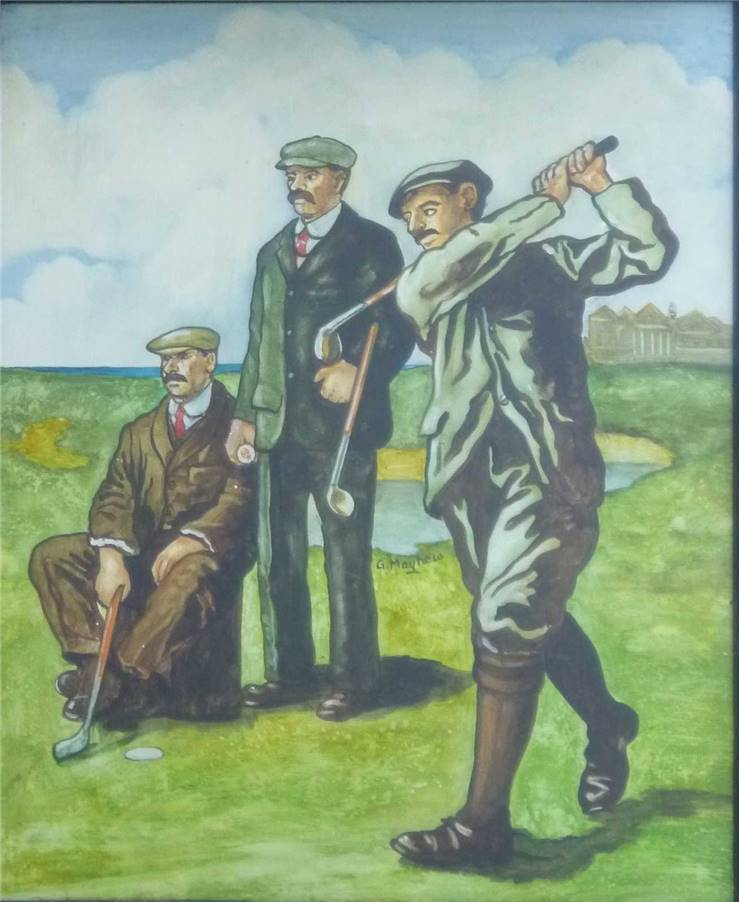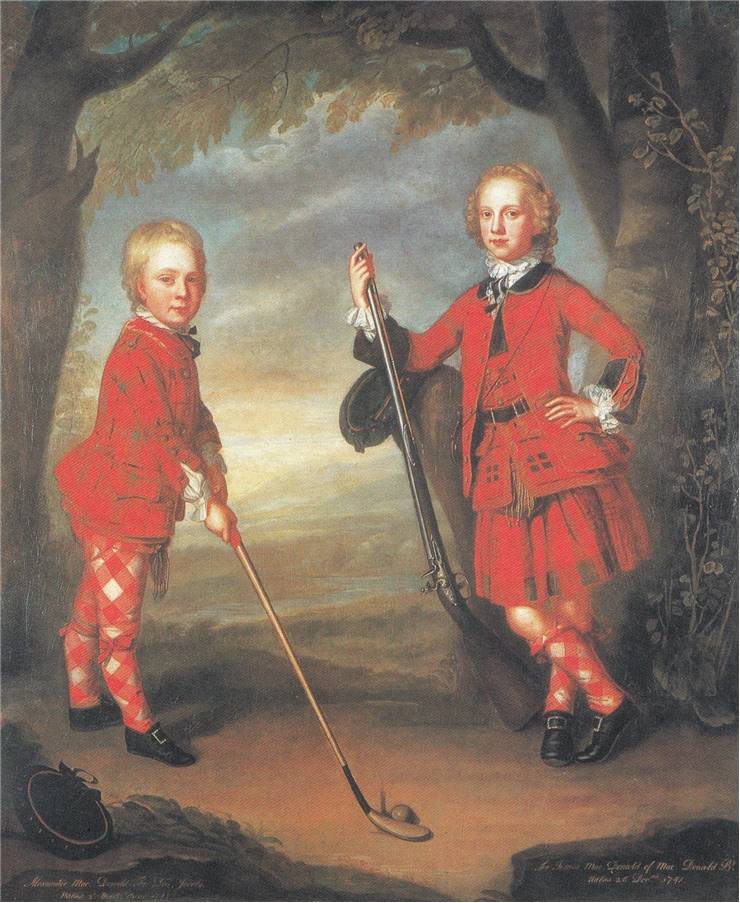History of Golf - Where And How Golf Game Started?
The name golf originated from the Dutch word kolf or kolve, meaning "bat" or "club," and a name for a stick used in a game called kolvn. There are many ball-and-stick games similar to golf that was played in ancient times.
That being said, almost every civilization played some game that included ball and stick with variations in rules and form. One of the most popular and famous games was “Gowf,” as it was known in Scotland. On Scotland’s east coast, the game was played by the citizens of Leith, St. Andrews, and Aberdeen, and it has been raised to a great game that is loved and played by millions of people.
Possible Golf Origins - Pre-14th Century Golf History
Paganica from Ancient Rome
One of the first forms of the game similar to modern golf is a Roman game of Paganica. In that game, players hit a feather-stuffed leather ball with club-shaped tree branches. Balls were bigger than today's golf balls, with 15 centimeters in diameter. Paganica was played in many parts of the Roman empire during the first century BC, and the game probably had many different names and variations.
Kolven from the Netherlands
In the Netherlands, there is a game called Kolven of Kolf. Apart from similarities in rules, the name golf originates from that game’s name. In Kolven, four players hit the ball over some distance, and the winner is the first player that reaches their opponents’ starting point. This game was first mentioned in a Middle-Dutch manuscript by Boeck Merlijn written by the Flemish poet Jacob van Maerlant in 1261. Its council banned the game of kolf in Brussels in 1360 with a fine of 20 shillings to whoever broke the ban.
Chuiwan from Ancient China
Another game with rules similar to modern golf is a Chuiwan (where “Chui” means hitting and ”wan” means small ball in Chinese), which was played in ancient China and it was described as a “game in which you hit a ball with a stick while walking.” The game dates back to 943 AD, during the Song Dynasty, and was the favorite game among palace maids and ordinary people. Even the emperors played it, and the imperial clubs were made of precious stones and gold. The game also became a competitive sport. Later, during the Oing dynasty, the game was rarely played.
Cambuca from England
There is also a record of a game similar to golf called Cambuca (a term of Celtic origin) played in England in the 12th century. Like Paganica, the game was played with a leather ball and a bent club.
Hurling from Ireland
Hurling is a game that originated in Ireland. The game aims to hit a ball with a wooden stick into the opponents’ goalposts. The game is probably more than three thousand years old. It is one of the Gaelic games native to Ireland, and it was played by teams representing neighboring villages. There are many similarities between Hurling and Gaelic football. The game of Hurling was originally played on ice and grass, but because of the mild climate in Ireland, it was usually played on grass. The only time that hurling was in the Olympics was at the 1904 Summer Olympics in St. Louis, Missouri, in the United States.
Shinty from Scotland
Another game played with stick and ball in Scotland is very popular: Shinty. The game has some similarities with field hockey, but also some important differences. Today it is played mainly in the Scottish Highlands and, traditionally, during the winter months. On New Year’s Day, the villages would play Shinty. The game is played with a wooden stick slanted on both sides and called a "caman." Like Hurling, it is usually paled on grass because of the weather, but it can also be played on ice. Shinty also has the same root as the Welsh game of bando.
Jeu de mail from France
A game called Jeu de mail or jeu de maille is a lawn game played in France during the Late Middle Ages. The first record of the game is a text from 1416. The game can be described as a ground billiard with several different rules variations. There were still some places where the game was played in the 20th century.
Chaugan from the Middle East
A game called Chaugan is played in the Middle East and has similarities with polo and golf. It is played with a ball, horses, and sticks. The translation of a name can be “four corners.”
Golf Beginnings - 1353 – 1850
Golf was banned, along with football, by King James II in 1457. It was done to preserve the skills of archery. The ban was also reaffirmed by the kings James III and James IV. In 1502, the ban was finally lifted after signing the Treaty of Perpetual Peace between Scotland and England. After that, King James IV made the first recorded purchase of golf equipment. The first recorded female golf player was Mary, the Queen of Scots, in 1567. The first golf ball (feathery ball) was invented in 1618. Golf was banned in Albany, New York, in 1658, the first record of golf in America. Many English kings played golf, such as Charles I and William IV. Many golf clubs were formed at that time as well. The first golf match reported in a newspaper was between Captain John Porteous and Alexander Elphinstone in 1724. The first book describing golf is Thomas Mathison's epic The Goff, published in 1743. The guta-precha ball, or the “guttle,” was invented in 1848, which was much less expensive to make and helped the game expand.
History of Modern Golf – 1851-1945
This part of golf history was marked by forming many new golf clubs, such as The Prestwick Golf Club, The King James VI Golf Club, and much more. In 1860 Willie Park Senior of Scotland won the first Open Championship in Prestwick. Oxford won the first University Match played in the London Scottish Golf Club course at Wimbledon in 1878. At the beginning of the 20th century, Walter Travis won three U.S Amateurs and published his book Practical Golf.
Post-WWII Golf –1946-Today
In 1947 golf was broadcast via television for the first time. Many golf magazines were born during this time. The first golf magazine was Golf World. In 1973 the graphite shaft was invented. At the end of the century, many new materials for golf clubs were introduced, such as metal, stainless steel, graphite, titanium, carbon fiber, and tungsten.
Golf History by Countries
The first record of golf in the United States was in 1657 when two drunk men were arrested for breaking the windows by hitting balls with the stick. Next year golf was prohibited in that state. The Northeastern United States was the first part of the country where people started playing golf. The oldest golf club in the US is Savannah Golf Club, established in 1794 or 1795. The first golf course was built in February 1888 by John Reid. The game of golf spread slowly because the country is recovering from the Civil war. Golf became more popular in Canada than in the US at that time. USGA - The United States Golf Association was established in 1894, and in 1916, The American Professional Golfers Association or PGA was formed. Today, there are more than ten thousand USGA-affiliated golf clubs.
The first golf club in Japan was formed in 1903 by British expatriates. A golf course at Kobe was constructed at that time. In 1914, the Tokyo Golf Club was founded. After World War II, golf gained much popularity in Japan, and by 2009, there were over two thousand and four hundred courses countrywide. There are also many golf courses built throughout the Pacific Rim, which was caused by the popularity of golf in Japan.
Some people believe that golf was played in Melbourne, Australia, back in 1847, but the Royal Adelaide Golf Club was the first club formed in 1870. In 1873, the Christchurch Golf Club was formed in New Zealand.
English architect Edvard Milner made the first golf course in Sweden on a private Estate in Ryfors in 1888. It had six holes.

